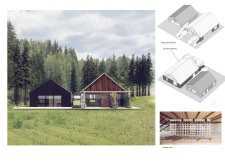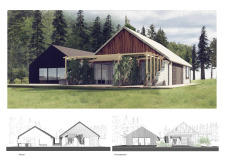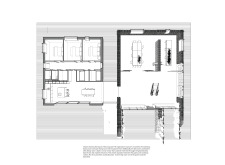5 key facts about this project
The design of the Tea Makers Guest House revolves around two main structures: a new building characterized by its minimalist timber and glass façade, and an existing barn that has been thoughtfully preserved and adapted for modern use. This juxtaposition emphasizes the relationship between old and new, allowing the project to honor its historical context while serving current practical needs.
Sustainability is a key consideration in the architectural design of the guest house. The selection of locally-sourced materials, such as timber and stone, supports ecological balance and reduces the carbon footprint. The incorporation of large glass panels enhances light penetration while providing panoramic views of the natural setting, fostering a connection between interiors and exteriors. Additionally, features such as rainwater harvesting and the potential for solar energy integration reflect a commitment to responsible environmental practices.
Unique Approach to Design
One of the defining aspects of the Tea Makers Guest House is its dual functionality, which allows the space to operate as both an accommodation facility and a community workshop. This holistic design approach encourages social interactions while maintaining privacy for guests. The existing barn, reimagined to serve various functions, creates a versatile environment that supports artistic endeavors and communal craft activities.
The architectural layout prioritizes communal living by placing a significant emphasis on shared spaces. The open-plan design of the new building promotes interaction among guests, while carefully placed private rooms ensure individual comfort. This balance between communal and private spaces distinguishes the project from typical guest houses that might prioritize one over the other.
Adaptive Reuse and Community Integration
The preservation and repurposing of the existing barn exemplify an adaptive reuse strategy that enhances the architectural narrative of the project. By retaining the historical structure, the design acknowledges the cultural significance of the site while extending its usability. This approach not only preserves local craftsmanship but also encourages visitors to engage with the history of the area.
The incorporation of sustainable practices further aligns the project with contemporary architectural ideas that prioritize integrity and responsibility. The design is informed by principles of ecology and community, establishing a framework that invites guests to immerse themselves in both nature and local culture.
For a comprehensive understanding of the project, readers are encouraged to explore architectural plans, sections, and design details. Such elements provide deeper insights into the architecture and unique features of the Tea Makers Guest House, facilitating a thorough examination of its design philosophy and practical applications within the community.


























